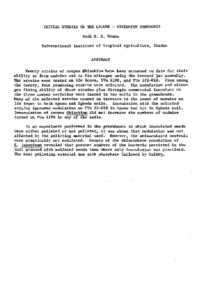Initial studies on the legume: rhizobium symbiosis
Abstract
Twenty strains of cowpea Rhizobium have been screened to date for their ability to form nodules and to fix nitrogen using the Leonard jar assembly. The strains were tested on Ife Brown, TVu 1190, and TVx 222-01B. From among the twenty, four promising strains were selected. The nodulation and nitro-gen fixing ability of these strains plus Nitragin commercial inoculant on the three cowpea varieties were tested in two soils in the greenhouse. Many of the selected strains caused an increase in the count of nodules on Ife Brown in both Apomu and Egbeda soils. Inoculation with the selected strains improved nodulation on TVx 22-01B in Apomu but not in Egbeda soil. Innoculation of cowpea Rhizobium did not increase the numbers of nodules formed on TVu 1190 in any of the soils. In an experiment performed in the greenhouse in which inoculated seeds were either pelleted or not pelleted, it was shown that nodulation was not affected by the pelleting material used. However, the uninoculated controls were practically not nodulated. Counts of the rhizosphere population of R. japonicum revealed that greater numbers of the bacteria persisted in the soil planted with pe11eted seeds than where only inoculation was practised. The best pelleting material was rock phosphate followed by CaSi03.

